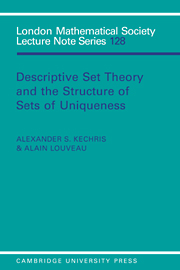Book contents
- Frontmatter
- Preface
- Contents
- INTRODUCTION
- ABOUT THIS BOOK
- CHAPTER I TRIGONOMETRIC SERIES AND SETS OF UNIQUENESS
- CHAPTER II THE ALGEBRA A OF FUNCTIONS WITH ABSOLUTELY CONVERGENT FOURIER SERIES, PSEUDOFUNCTIONS AND PSEUDOMEASURES
- CHAPTER III SYMMETRIC PERFECT SETS AND THE SALEM-ZYGMUND THEOREM
- CHAPTER IV CLASSIFICATION OF THE COMPLEXITY OF U
- CHAPTER V THE PIATETSKI-SHAPIRO HIERARCHY OF U-SETS
- CHAPTER VI DECOMPOSING U-SETS INTO SIMPLER SETS
- CHAPTER VII THE SHRINKING METHOD, THE THEOREM OF KÖRNER AND KAUFMAN, AND THE SOLUTION TO THE BOREL BASIS PROBLEM FOR U
- CHAPTER VIII EXTENDED UNIQUENESS SETS
- CHAPTER IX CHARACTERIZING RAJCHMAN MEASURES
- CHAPTER X SETS OF RESOLUTION AND SYNTHESIS
- LIST OF PROBLEMS
- REFERENCES
- SYMBOLS AND ABBREVIATIONS
- INDEX
ABOUT THIS BOOK
Published online by Cambridge University Press: 07 September 2010
- Frontmatter
- Preface
- Contents
- INTRODUCTION
- ABOUT THIS BOOK
- CHAPTER I TRIGONOMETRIC SERIES AND SETS OF UNIQUENESS
- CHAPTER II THE ALGEBRA A OF FUNCTIONS WITH ABSOLUTELY CONVERGENT FOURIER SERIES, PSEUDOFUNCTIONS AND PSEUDOMEASURES
- CHAPTER III SYMMETRIC PERFECT SETS AND THE SALEM-ZYGMUND THEOREM
- CHAPTER IV CLASSIFICATION OF THE COMPLEXITY OF U
- CHAPTER V THE PIATETSKI-SHAPIRO HIERARCHY OF U-SETS
- CHAPTER VI DECOMPOSING U-SETS INTO SIMPLER SETS
- CHAPTER VII THE SHRINKING METHOD, THE THEOREM OF KÖRNER AND KAUFMAN, AND THE SOLUTION TO THE BOREL BASIS PROBLEM FOR U
- CHAPTER VIII EXTENDED UNIQUENESS SETS
- CHAPTER IX CHARACTERIZING RAJCHMAN MEASURES
- CHAPTER X SETS OF RESOLUTION AND SYNTHESIS
- LIST OF PROBLEMS
- REFERENCES
- SYMBOLS AND ABBREVIATIONS
- INDEX
Summary
Since we view this book as addressed to both logicians or set theorists and analysts, we tried to keep the prerequisites from each field to a minimum, so we believe it is essentially self-contained modulo some basic material. As far as the analysis is concerned we assume only a familiarity with the fundamental results of real and complex analysis (complex methods are actually used rarely), and the elements of functional analysis, i.e. with topics covered in the first or second year of graduate studies. Typical references for them are Stromberg [1], Hewitt and Stromberg [1], Rudin [1J and Rudin [2, Chapters 1–4]. Also for becoming a little more familiar with the basics of harmonic analysis the reader can consult the first chapter of Katznelson [1J. From set theory the reader should be acquainted with its elements, including transfinite induction and ordinals. Some references here are Halmos [1], Enderton [1] or the first SO pages or so of Jech [11. Beyond that one needs some classical results in descriptive set theory concerning basic properties of Borel, analytic and coanalytic sets. These are all summarized in Chapter I V.I and can be found with detailed proofs in any standard text, like Kuratowski [1, Vol. I, §33–39] or Moschovakis [1, Ch. 1, 2].
Except for this background, as a general rule we develop in detail all the material from analysis or descriptive set theory that we need. This necessitates the inclusion here of standard results from books or other references for which we claim no originality in either the context or the presentation, in particular there is no implication that results for which no specific credit or reference is given, usually because of lack of relevant information, are due to the authors.
- Type
- Chapter
- Information
- Publisher: Cambridge University PressPrint publication year: 1987



